| 1 | Baja California coachwhip |
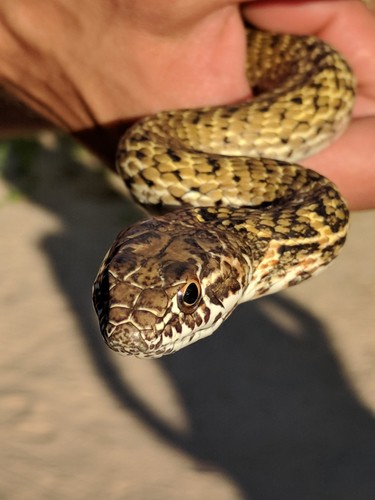
Probably the most commonly sighted snake in Baja California by ordinary people. Masticophis fuliginosus belongs to the same genus as the US coachwhip (a notoriously fast snake). It’s a non-venomous species, yet highly aware and alert, and always ready to bite interlopers with the slightest excuse.
This species is found all over Baja California, from north to south, and crosses the border into San Diego County, USA. They’re most common in drier areas of Baja California, such as scrubland, rocky arroyos, thorn forests and coastal flats.
Like the US coachwhip, this is an especially fast moving and twitchy snake. The Baja California coachwhip moves almost exclusively by day, and their favourite hunting strategy is to hide in dark mammal burrows, poke just their head out, and scan their surroundings for prey using their strong eyesight.
The Baja California coachwhip mainly preys on reptiles, including central Baja spiny lizards, desert iguanas, and orange-throated whiptails. Some snakes always swallow headfirst, but Masticophis fuliginosus can bite a lizard at the mid-section, before skillfully folding it into its mouth. They also take shelter in mammal burrows for shelter against the beating Mexican sun.
The Baja California coachwhip is shorter than the US version, at an average of 62-132cm, but still reaches a maximum of 184.5cm. This snake has two colour phases: 1) yellow with dark zigzagging bands, and 2) dark brown all over, with light edges to scales.
| 2 | Baja California rattlesnake |
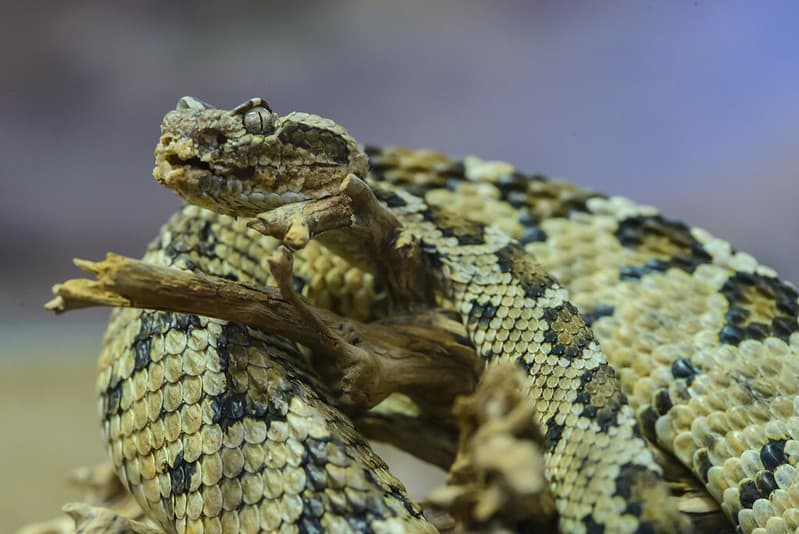
Baja California’s main venomous snake. Unlike the red diamond rattlesnake, this species doesn’t quite cross the border into US California, but they come very close. This rattlesnake is found in virtually all of Baja California, but is most abundant in the southern half.
Baja California rattlesnakes (Crotalus enyo) are a small species, reaching a maximum of 89.8cm. They sometimes slither into human areas, and take refuge below piles of trash, but this is mainly a snake of arid areas, interspersed with cacti and shrubs. They can be found on sand dunes, while in the east, they appear in pine-oak forests, but they never appear in dense jungles. Baja California rattlers have also been dragged out from under porches, and mammal burrows are their favourite natural refuge. This rattlesnake is crepuscular, coming out to play at dawn and dusk.
Crotalus enyo is far from the worst rattlesnake, as they have a small venom yield of just 31mg, compared to a western diamondback at over 175mg. Two studies have been conducted on their diet. One recorded 60.3% mammals, 33.3% reptiles, and 6.4% centipedes, while a 2016 study from the cape region was more tilted towards mammals at 83.3%, versus reptiles at 16.7%. Both studies found that spiny pocket mice were a popular prey.
| 3 | Coast patchnose snake |
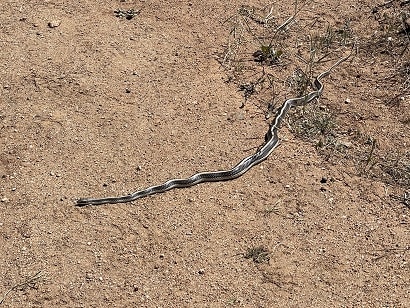
This harmless snake lives in dry parts of northern Baja California, especially in coastal sage scrub and chaparral. The coast patchnose snake is a shy species which usually stays under cover, and will never slither directly up an open hillside where birds can effortlessly grab them. This snake is named for a strange “patch” shaped scale on the front of their snouts, which is theorised to be for digging up lizards and their eggs.
Coast patchnose snakes (Salvadora hexalepis virgultea) reach a maximum of 115cm, and are typically 65-90cm. They look vaguely similar to a US garter snake, with a yellow vertical stripe down their spine, and dark black on either side. This snake is actually a subspecies of the western patchnose snake (Salvadora hexalepis), which is abundant all over the southwestern US. The most common subspecies in California and Nevada is the Mohave patchnose snake, but the coastal subspecies dominates Baja California, as well as extreme southwest California, near San Diego.
Coastal patchnose snakes are one of the more mysterious snakes in the Californian neighbourhood. This subspecies has barely any research to its name at all. They’re rarely spotted near San Diego, while in Baja California, they’re a total enigma. In most encounters, they’re completely non-aggressive, including when cornered and picked up.
| 4 | Baja California gopher snake |
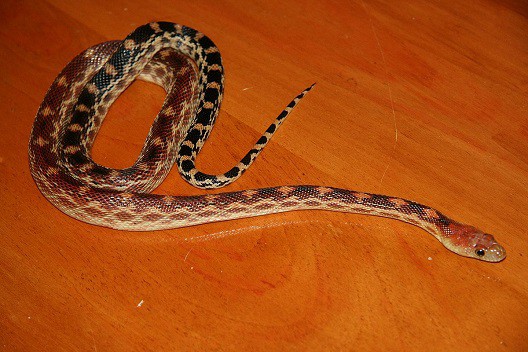
This relative of the US gopher snake inhabits the whole of Baja California, except parts of the north. They’re also found on outlying islands in Baja California, including Islas Magdalena, Santa Margarita and Isla San Jose. This snake begins life at 30-48cm, before steadily growing to reach an all-time record of 178cm.
Cape gopher snakes are very common, yet no detailed scientific surveys have ever been conducted. What we know is mainly anecdotal. In captivity, they gobble up pinkie mice, deer mice and lab rats with a vengeance, which is in line with the mammal-loving ways of US gopher snakes.
Cape gopher snakes have been found in dry areas like scrubland and sandy desert. However, they also appear in the high altitude Sierra de la Laguna (2134 metres), an internationally protected zone rich in pine and oak woodlands. They likely spend the day underground, escaping from the roasting Mexican heat, enjoying the cool darkness of their subterranean tunnels. One found as a roadkill exceeded 2 metres, although this may have been an outlier, as snakes tend to relax and elongate slightly when dead.
This snake has two subspecies, both contained entirely within Baja California. Pituophis vertebralis vertebralis is the cape gopher snake – found only on the southern tip of Baja California. This version has sharply contrasting orange and black patterns, with a red head from a bird’s eye view. P. v. bimaris is called the Baja California gopher snake, and is far more common, almost reaching the California border. This subspecies tends to be yellow-black instead.
| 5 | Sonora straminea |
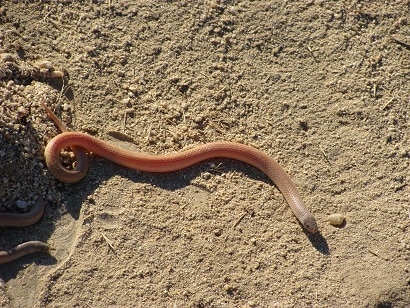
This shy snake is found only in the southern tip of Baja California. Banded sand snakes (Sonora straminea) reach a maximum of just 30cm and are no threat to human beings. They’re superb swimmers, but not in the way people are used to. Instead, they glide effortlessly through the upper layers of soft sands, a couple of centimetres down, just out of sight.
They’re specialised for this life in every possible way, with a shovel shaped head which is perfect for digging downwards. This is a brown and shiny snake, sometimes toffee-coloured, with black dots for eyes, and an expression as though it would never dream of hurting you. The reality is similar, as Sonora straminea is non-venomous and too small to do any damage with a bite. If picked up, they either do nothing or wrap themselves harmlessly around your finger. One consistent feature is that their head is paler, sometimes lightening to grey. They have a pink tongue with a white tip.
Sonora straminea was only born as an official species in 2018, when it was broken off from the widespread variable sand snake (Sonora semiannulata). Their natural habitat is empty, wide open spaces covered with hot sand and cacti.
| 6 | Baja California ratsnake |
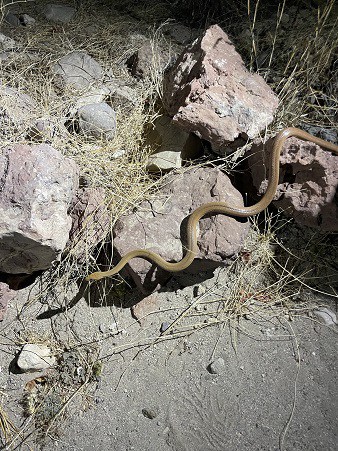
The Baja California ratsnake (Bogertophis rosaliae) is a unique species which is the only member of its family. It lives in the whole of Baja California from head to toe, and is a moderate sized snake, ranging from 85cm to a maximum of 152cm. Baja California ratsnakes are completely harmless to humans, with no venom or urge to mindlessly attack.
This snake lacks complex patterns, but has variable colours. They can be a colourful pink or they can have yellow-green tinges, while their eyes are some of the bluest of any snake. This is yet another lover of dry rocky habitats, which isn’t surprising given that Baja California is a dry rocky place. Canyons, bajadas, and thorn scrub are all potential hangouts of the Baja California ratsnake. They particularly like rocky arroyos close to small springs.
This snake is the subject of a mystery. Once upon a time, they were confined solely to Baja California on official maps. Then in Imperial County, a single Bogertophis rosaliae turned up 2.4km north of the US border. It was dead on a road, and confirmed rumours of more ratsnakes have appeared since then.
Thanks to the heat of Baja California, this snake can be active all year in the south, skipping hibernation. In the north, close to the US border, they’re active from February to October.
| 7 | Cape garter snake |
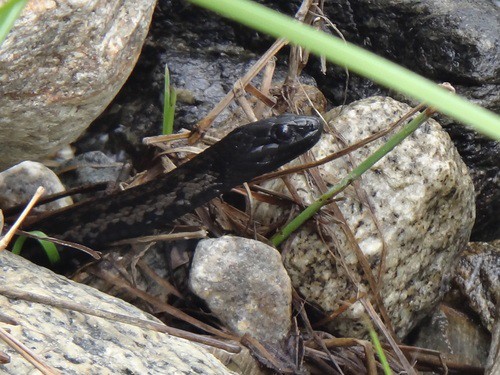
A garter snake found only in the south of Baja California. This species spends its life in streams, similarly to the aquatic garter snake of the US. Its younglings stick to the shallow rocky edges, hunting for tadpoles, while they gain the confidence to swim in deeper waters. Adults can dwell in the faster-flowing centres of streams, searching for amphibians and fish.
Cape garter snakes instinctively know their way around their watery domains, and when spooked, they instantly head for a large boulder to hide under. They can hold their breath for many minutes underwater, and have a mild venom which is harmless to humans.
This is one of the more elegant-looking garter snakes. They have a jet black head, while their lower bodies are speckled with honey-coloured scales. Their bellies, meanwhile, are covered with sharply contrasting black and white bars. Their eyes are extremely black, and at first glance, they resemble a US watersnake more than a garter snake.
Cape garter snakes (Thamnophis validus celaeno) are actually a subspecies of the more widespread west coast garter snake, which is found in western mainland Mexico. However, the cape form only appears in Baja California. Generally, the mainland forms are greyer. As a whole, the west coast garter snake species reaches a maximum of 110cm, with females being significantly longer.
| 8 | Cape thread snake |
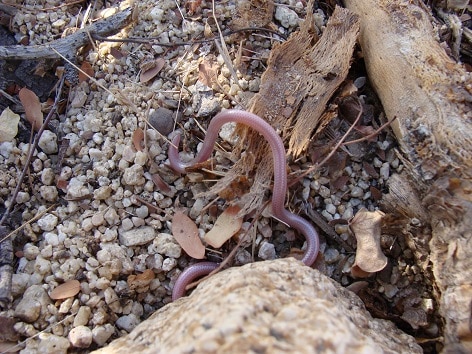
A harmless snake which is incapable of killing a human. There’s only one place on Earth to find this tiny snake – the southern tip of Baja California.
Cape thread snakes (Rena boettgeri) are a fossorial snake with mere black pen dots for eyes, which are adaptions for their reduced light requirements. They only leave their subterranean soil domains after heavy rains, and have a maximum length of just 22.5cm, with an especially short tail representing just 5% of total body length.
Their scales are extremely smooth, making them look like a worm, which is an adaption for gliding smoothly through soil. Their favoured habitat is dry coastal chaparral – in a rainforest, they wouldn’t know what to do.
The cape thread snake belongs to the Rena genus (10 members), the same as the Texas blind snake. Whether cape blind snakes are completely blind is a mystery, but it’s assumed that they can sense whether it’s daylight or not, and little more than that. Cape thread snakes prey mainly on insects, and are more common near small streams within their dry chaparral landscapes, sometimes on the sandy banks.
| 9 | San Lucan rattlesnake |
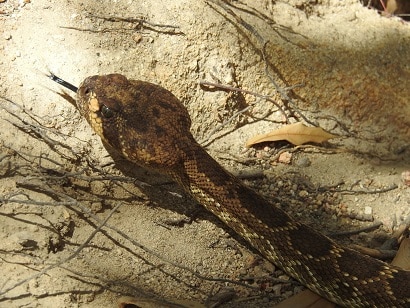
A subspecies of the red diamond rattlesnake, which also lives in California. This version (Crotalus ruber lucasensis) lives only in Baja California, and has its own grand title. They’re particularly concentrated in the far south, and are most commonly witnessed by normal people on sandy dirt roads.
San Lucan rattlesnakes have the usual diamond-shaped patterns, but are slightly less red than the California version. This rattlesnake has brown-beige scales, a triangular head, and a black tongue which turns white, before reverting to black again at the very tip.
This species doesn’t have the deadliest venom of any rattlesnake, but the potency varies significantly by region. A 2020 study found that in the Magdalena Plains region, the LD50 toxicity score was just 6.8mg, while on the central gulf coast, it was a far nastier 1.4mg, which outstrips a cottonmouth. Both regions are in southern Baja California. The venom profile is dominated by haemorrhagins, rather than the neurotoxins of a tiger rattlesnake, but this probably varies by region too.
The maximum length for the red diamond rattlesnake overall is 162.5cm. While we don’t have any specific records for the Baja California subspecies, it regularly exceeds 100cm just like its US populations.
| 10 | Mosauer’s ground snake |
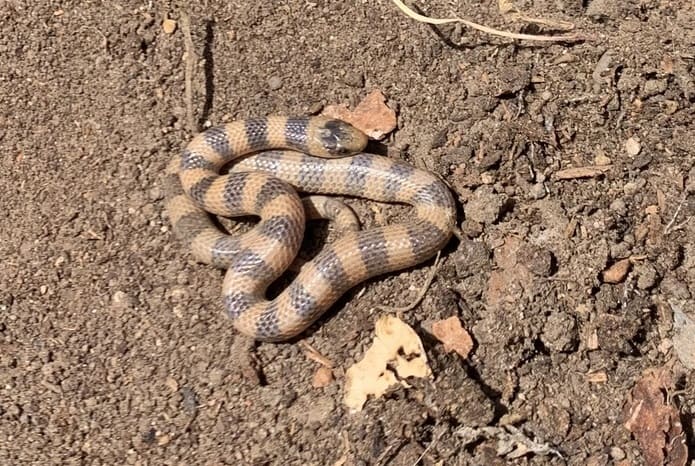
A shy snake which isn’t seen often, but inhabits the majority of Baja California, from north to south. Mosauer’s ground snake (Sonora mosaueri) is harmless to humans, and is most commonly found as roadkill after falling victim to the screeching impact of car tyres.
Mosauer’s ground snake is a small species measuring 30-40cm, which varies wildly in appearance. They typically have evenly spaced bands, which are especially neat and orderly, as you can see above. These vary in colour, as some are pink and pale black, while others are dark black contrasting against white. Another chunk have no bands at all, and are a consistent fleshy pink.
This species belongs to the same genus as the western ground snake (Sonora semiannulata) of California. Mosauer’s ground snake has been on a rollercoaster ride, as it was originally discovered in 1938. It was its own species for decades, until 1983, when it was declared to be a subspecies of Sonora semiannulata. Then in 2018, mitochondrial DNA analysis confirmed it to be an independent species after all.
Officially, Mosauer’s ground snake doesn’t stray into US California, but it’s such a shy snake that anything is possible. This species may secretly have a tiny foothold in the far south. There’s no length record for this species yet, but the original Mosauer’s ground snake discovered in 1938 measured 30.9cm.
